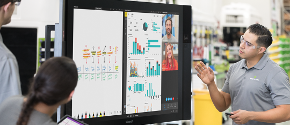
Using online tools to create a collaborative workplace: Part 1

What does a modern workplace look like? There’s lots of answers to this question, but more and more organisations are empowering employees to work when and where they feel best. There are over four million remote workers in the UK currently. To successfully stay connected with their co-workers, many teams turn to virtual workspaces such as Teams and Sharepoint to fuel communication and create a collaborative workplace.
In this first part of this series, we’ll be taking a closer look at Microsoft Teams, and some practical steps and tips to help you get the most out of it.
Fuelling a collaborative workplace
According to a recent PowWowNow survey, we spend 68 percent of our day communicating with each other. Using a social-based collaboration tool like Microsoft Teams can make this easier. It’s intuitive, works across a range of devices and makes file sharing easier, leveraging the cloud so you always have the latest version. Collaborative tasks in the workplace and made to feel more natural. As a virtual workspace, it’s great for teams based in offices and for those working remotely too. People work best when they feel they are part of a successful team, and this is possible on Microsoft Teams with chat, video calling, and meeting functionalities rolled into one.
With end-to-end security, Teams makes it easy to control user and third-party access so your employees can spend more time doing the work they love, with the knowledge that they are secure and compliant. Below are some tips to help get the best out of Teams.
5 tips to empower a collaborative workplace with Microsoft Teams
1. How to set up a Teams site
Setting up a Teams site is easy – just click Teams on the left side or the app, then ‘Join or create a team’ followed by ‘Build a new team from scratch’.
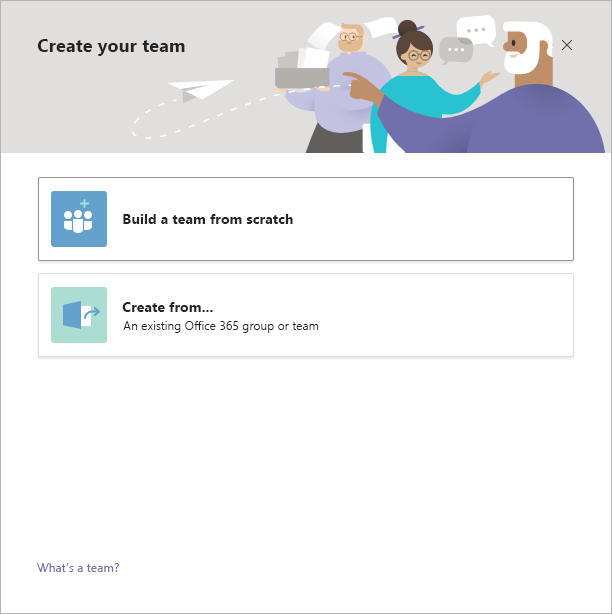
When you set up a new team it creates a new Office 365 group, a SharePoint site and document library, an Exchange Online shared mailbox and planner, a OneNote notebook, and ties into other Microsoft apps.
Then the world is your oyster! Add the members of your team and choose if you want it to be private or public. To add members, click More options > Add members on your Team. You can add individual people, or type in the name of a contact group, security group, or Office 365 group to add multiple people.
From there you can add channels. These channels can be separated by project, topic, or department. They are where you set up your apps, folders, and documents. This is where teamwork gets done, in an open, collaborative workplace.
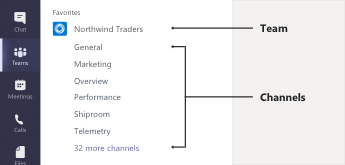
To create a new channel, start in the team list. Find the team name and click More options > Add channel. You can also click Manage team, and add a channel in the Channels tab.
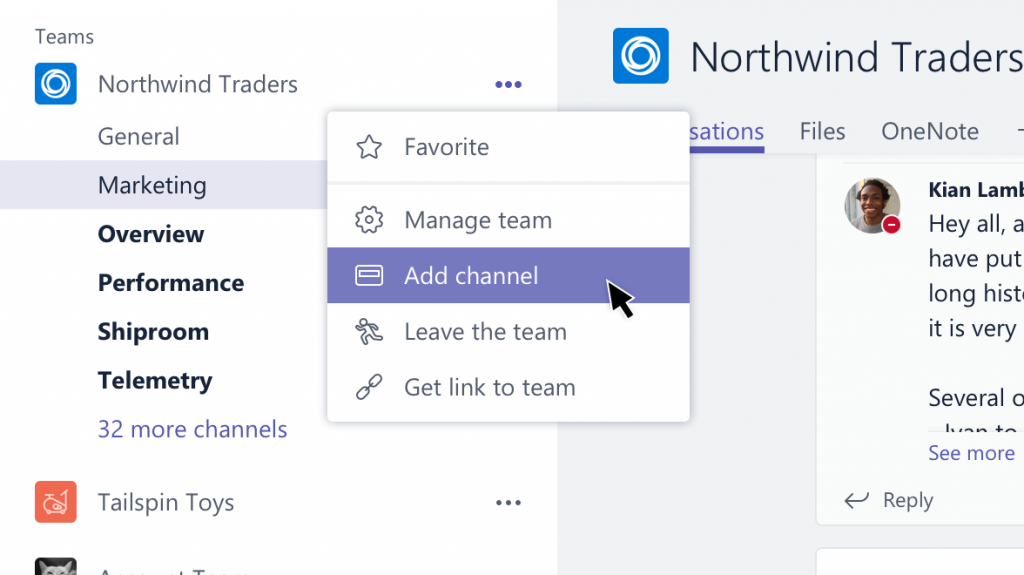
The channel is where you can hold team conversations. You can also add a document library to share team documents, link to OneNotes, calendars, even Power BI or Twitter feeds. Just press the + on the channel tab list to add the apps that are most relevant for your team.
Expert Teams tip: Cut down on inbox churn by sending an email via Teams. Go to the channel name and click More options > Get email address. The email will then be displayed in the conversations tab for all team members to view and reply. This makes the email searchable and promotes collaboration on team projects. If you have added attachments, they’re automatically uploaded to Teams, meaning you can control any versioning and make it easier to find.
2. Collaboration made easy
 Because Office 365 is built into Teams, it makes it easier to collaborate on documents. There are no more confusing duplicates bouncing around in emails – you can even see the edits as they’re being made! And because documents are saved in the cloud, each member can be confident they’re working on the latest version.
Because Office 365 is built into Teams, it makes it easier to collaborate on documents. There are no more confusing duplicates bouncing around in emails – you can even see the edits as they’re being made! And because documents are saved in the cloud, each member can be confident they’re working on the latest version.
Conversations about these documents can be had more quickly on Teams – no need to wait for sign off or face-to-face meetings when someone is a quick message or virtual meeting away. Plus, you can chat while you edit on screen, meaning you can quickly finalise those last-minute edits.
Expert teams tip: Add Microsoft Planner to your channel to help keep up-to-date on team tasks and projects. You can organise work visually, assign tasks, share files, and create a visible and transparent place where everyone knows who is working on what.
3. Do remote meetings better
For teams who are spread out, getting together for meetings can be time consuming and expensive. But in Teams, all you need to do is create a Channel Meeting. Everyone in that team are automatically added, and any discussion before, during, or after the meeting relating to it are saved and visible to everyone.
You can schedule private meetings in the Meetings tab on Teams. You can also organise meetings via Outlook Calendar, just click on New Teams Meeting. A Teams meeting doesn’t only have to be with co-workers, you can invite guests who don’t have access to your Team too – each meeting generates a conference ID and number for participants to join.
In a Teams meeting you can record the meeting, take notes, and share files. These are automatically saved and easily available to use later, making post-collaboration easy. Participants can also blur their background to keep the focus on them.
Use the Share Tray to share your desktop, or a window or a PowerPoint. This ensures meeting participants will only see what they need to.
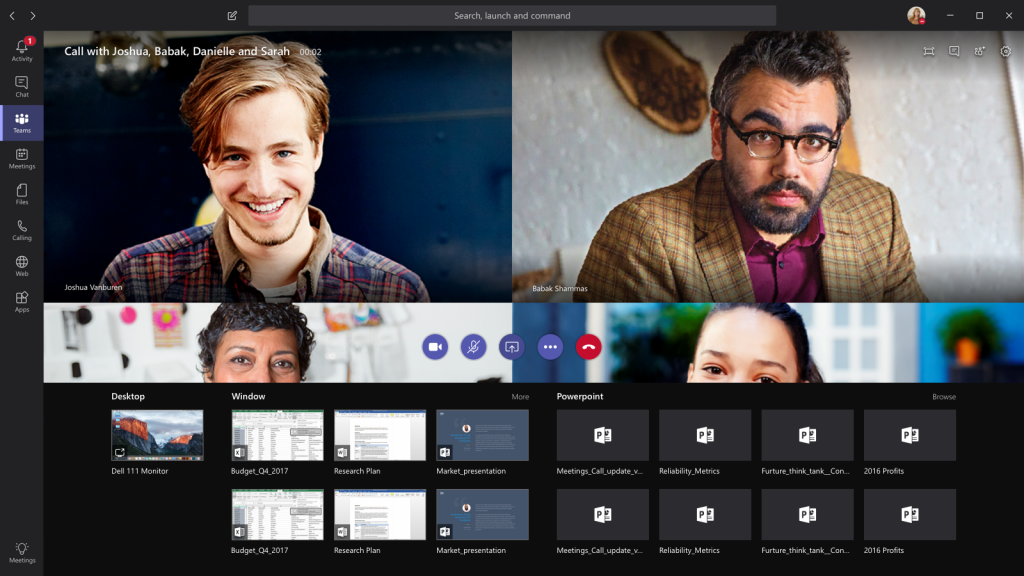
Also, within Share Tray is Microsoft Whiteboard. You can use whiteboard to sketch, brainstorm or collaborate together in real time.
For those in the office, they can use the Surface Hub 2S as a whole whiteboard while sharing with others online. Both in-person and virtual attendees will be able to easily collaborate together, and the content will be saved after.
Expert Teams Tips: Soon you’ll be able to make your Teams meeting more inclusive with live captions and subtitles. Whether you have attendees that are hard-of-hearing, have different level of language proficiency, or are connecting from a loud location, they’ll be able to contribute to the conversation easily.
4. Keep secure and safe
Because Teams is part of Office 365, you benefit from robust security and compliance. Being in the cloud means Teams is constantly updated with secure policies. It uses Azure Active Directory to manage users, multi-factor authentication, and access control. Because it is easily controlled from one directory and managed across all Office 365 apps, it makes it easier for your IT team to control. And this means sign on is done once, making it fast and easy for your employees to access on any device.
Each team can be made private, meaning you can limit control over who has access. You can even invite partners and vendors who aren’t in your organisation to Teams. Soon, you’d be able to further create secure channels within a Team. This means you don’t have to create a whole new Team to limit access to particular projects.
Conversations within those channels are public to team members, but individual chats are private. However, admin can implement data loss prevention (DLP) policies to detect, automatically protect, and screen for sensitive information in chats and channel conversations. This helps prevent sensitive information from unintentionally being shared or leaked.
Expert Teams Tip: Do a governance requirement check to ensure your meeting your requirements. We’ve created a handy checklist to start you off.
5. Teams and SharePoint
As mentioned, when you create a Team, it automatically creates a SharePoint site and document library for your team. To access your Teams’ SharePoint, click the dots on the top title bar and open in SharePoint.
![]()
In the SharePoint you’ll have access to your Teams conversations, documents, notebooks, pages, and contents. From here you can integrate your processes with Microsoft Flow, or create applications with PowerApps. Because it’s all accessible from Teams, it’s a complete virtual workspace which allows for seamless collaboration, easy communication, and faster innovation in a collaborative workplace.
Back on your Teams, you can add SharePoint pages and libraries directly to your Channel. Just press the + button on the Channel Tab and you’ll get the full SharePoint experience within Teams.
Expert Teams Tips: Have a SharePoint site and want to create a Team from it? It’s easy – just click the ‘Create a Team’ on your SharePoint site, or add the Office 365 group when setting up within Teams.
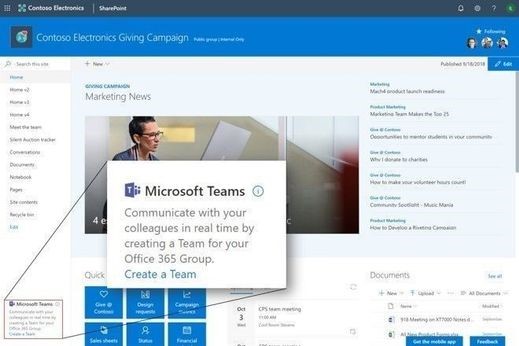
Give it a try and see for yourself how Microsoft Teams fuels the collaborative workplace and how seamless it makes communication. You won’t want to go back. Your employees will feel confident and connected no matter how far away they are from each other – 75 percent of people surveyed by PowWowNow agreed that technology helps improve productivity.
We’ve got more resources here to help drive adoption and create successful digital transformation in your organisation.
Next up, we’ll be focussing on SharePoint, and showing you the power it has to keep your organisation connected and drive your business forward.



